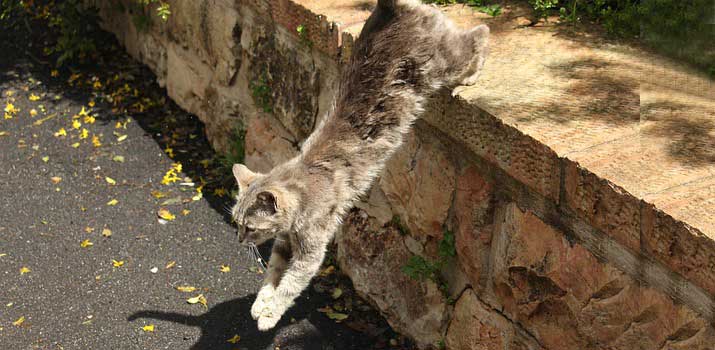Cats are notoriously independent. It’s one of the most beloved traits these animals have! While they can be clingy and affectionate, most will go off and do their own thing instead of staying by your side every waking hour of the day.
While admirable, that independent streak can cause some trouble now and again. Usually, moments of defiance are nothing a few enticing treats can’t fix. But what if the goal is to keep your cat from doing the things they love most?

If your can has to undergo surgery, one of the biggest challenges you’ll face is keeping them contained long enough for their wounds to heal.
Cats love jumping from one high surface to the next. Even painful incision sights and stitches aren’t going to stop that! It’s in their DNA to hop around.
Unfortunately, that behavior can lead to significant setbacks in your feline’s recovery. Significant physical activity can cause incisions to open, paving the way for infection and a much lengthier recovery window.
So how can you keep your cat from jumping after surgery?
Eight Ways to Stop Your Cat from Jumping After Surgery
It’s not easy, but there are several things you can do to stop your cat from going crazy after they wake up from surgery. Surgery is an unfamiliar experience for felines.
While they might be groggy for several hours after waking up from anesthesia, it won’t take long for your feline friend to start moving around.
Always follow post-op care instructions and keep a watchful eye on your cat moving forward. These animals are sneaky, so don’t rest on your laurels! Here are some tips to ensure that your cat stays relatively still to recover fully.
1. Keep Them in a Crate
Here’s the most obvious solution. But instead of treating it as your first solution, sticking your cat in a crate during the recovery period should be your last resort.
Most cats aren’t too keen on staying in a cramped crate for an extended period. It can feel like downright torture, so only use this method if it’s the only way you can ensure that your cat won’t jump.
Keep in mind that you can’t keep them in the crate forever. You will need to let them out occasionally to use a litter box and spread their legs.
If you’re not careful, a desperate cat will flee when you open the crate door! Make sure to have some backup and close all potential exits to keep your cat safe.
It may be worth talking to your vet about potential options for extended crate time. They might provide you with solutions that make things easier for your cat.
2. Confine Your Cat to a Single Indoor Space
If you don’t want to confine your cat to a crate, you can let them recover in a specific room. We recommend using a small room with very few hazards to contend with.
For example, you can keep them in a bathroom or small empty room without anything to jump on.
Before your cat comes out of surgery, look through the room for dangerous items and surfaces. Think like your cat and remove anything that might entice them to start jumping or running around.
Once the space is safe, put their litterbox in the and provide all the essentials.
3. Create a Calm and Quiet Environment
It doesn’t matter whether you’re keeping your cat in its crate, in a room by itself, or letting it recover in your home as usual. One of the most important things is creating a calm and comforting environment.
Cats have sensitive ears. They’ll jump and flee at the first loud sound that they hear. When they’re just waking up from anesthesia, that sensitivity is high. The last thing you want to do is scare your cat and cause them to reinjure themselves.
Before bringing your cat home, make sure that it’s quiet. Turn off alarms, clocks, and anything else that randomly makes noise.
If you have any kids with you, have a discussion about how they should behave.
Calmer cats will have no problem recovering with you by their side. But, it needs to be a low-stress environment they feel comfortable relaxing in. Otherwise, they’ll start acting crazy and unruly.
Keep the peace and walk on eggshells for a few days. It’ll feel like you’re being overly cautious, but that mindset can do a lot to improve to your cat’s well-being.
4. Take Down Trees and Climbing Surfaces
Have a cat tree in your home? What about a perch or jungle gym that your cat uses? Whatever the case may be, it’s best to take it down for now.
A tall cat tree is like an open invitation to jump on. Felines love cat trees, and having them in the vicinity is asking for trouble.
Consider disassembling it and removing the tree from the area your cat will spend most of its recovery time in. If that’s not possible, you can lay the tree on its side or cover it with a thick blanket.
The goal is to hide it from sight and eliminate any natural urges to play.
5. Hide the Toys
This tip is similar to the previous one about cat trees. Small toys are just as enticing! Cats are pretty easy to please in this regard, so it doesn’t take much to capture their attention.
Take away any small toy and ensure everyone knows not to use any lasers.
It might feel not kind to take away the things your cat loves as they recover. But you can’t take any chances. Anything that could send your cat into a tizzy should be hidden out of plain view.
You can save that fun for after your feline friend makes a full recovery from their procedure.
6. Quarantine Your Cat in Recovery
If you have other cats or even a dog in the house, you’ll need to keep them away from your cat. Socialization is important, but not in the aftermath of surgery. Your cat needs time to heal, and adding another animal into the mix only asks for chaos.
Your other pets don’t understand what’s happening or why your cat is suddenly so tired. There’s a good chance that they’ll try to perk them up, which will only trigger your cat to jump around and play. It’s cute but detrimental to the recovery process.
Here’s where keeping your cat in a dedicated room comes in handy. At the very least, create some barriers to ensure that none of your other pets disturb your healing cat.
7. Calming Supplements and Gadgets
Your vet likely gave you a detailed care packet covering the steps you need to take to help your cat make a full recovery. That may or may not include additional medications and antibiotics.
If it doesn’t, don’t be afraid to ask if it’s a viable choice for the situation. Sometimes, additional medication to keep your cat calm is necessary. Usually, vets treat that as a last-ditch effort. That said, they understand your cat’s history and personality. They might recommend using calming medications from the jump to ease the transition home and avoid any mishaps.
There are plenty of great calming sprays and treats, too. Make sure to ask your vet if those products are safe to use. As long as your cat is healthy and the product doesn’t interact with other medications, you should be good to go.
Follow the instructions for dosing or spraying, and the calming solution should help your cat mellow out.
8. Use a Cone
Last but not least, you can use a cone. Most people associate Elizabethan cones with canines. However, cat models are available, too.
Some are made of thick plastic, while others utilize heavy fabrics. Whatever the case, the cone will do a lot to prevent jumping. While it doesn’t restrict movement directly, the cone is far too cumbersome to move around in. Your cat will figure that out pretty quickly.
More importantly, is its effects on your cat’s senses. Cones block most of their view, severely limiting their ability to snoop around and get into trouble.
Helping Your Cat Recovery From Surgery
The post-surgery recovery process isn’t easy. There’s no way to get around that. It’s a whirlwind for your cat, so don’t be surprised if they lash out or misbehave. As an owner, it’s your job to be supportive and provide the best care possible. Here are some other tips to follow.
Keep an Eye on the Stitches, Bandages, and Incision
The whole point of preventing your cat from jumping after surgery is to allow the wound to heal. How long that takes depends entirely on the extent of the surgery. After a standard spay or neutering procedure, most cats are back on their feet after two weeks. But if the surgery was more extensive, such as an orthopedic procedure, it can be up to 12 weeks!
No matter how long it takes, always keep an eye on the incision. Vets use dissolvable sutures, so they should disappear naturally. However, you might have to replace bandages in the meanwhile.
When you do that, take note of the wound and how it’s healing. If you notice anything suspicious like unusual color or discharge, don’t hesitate to reach out to your vet.
Follow Your Vet’s Instructions
Of course, always follow your veterinarian’s care instructions to a tee. Whether that involves administering pain medication, cleaning bandages, or following a strict diet, heed their guidance. Your vet knows best and has probably done the same procedure many times before.
Go to all the follow-up visits and keep those lines of communication open. If any issues occur, give them a call.
Be Vigilant and Supportive
Our last tip is to be vigilant. Cats are cunning and mischievous, so you can’t let your guard down for a minute. All it takes is a moment of distraction for your cat to get into trouble.
Don’t let up until your feline friend is completely healed. Otherwise, they could reinjure themselves and experience a massive recovery setback. There’s not much you can do to speed things up, but be supportive. Shower your cat in love and praise while giving them the space they need to heal.
Conclusion
Keeping your cat calm and firmly planted on the ground after surgery is a tall order. But it’s necessary to ensure that they heal correctly. Follow these tips to create an environment conducive to peaceful recovery.
